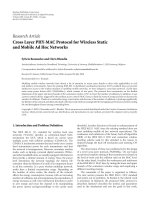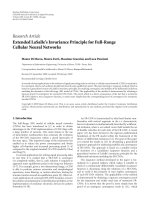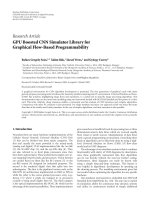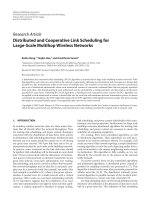Báo cáo hóa học: " Research Article Iteration Scheme with Perturbed Mapping for Common Fixed Points of a Finite Family of Nonexpansive Mappings" docx
Bạn đang xem bản rút gọn của tài liệu. Xem và tải ngay bản đầy đủ của tài liệu tại đây (495.93 KB, 8 trang )
Hindawi Publishing Corporation
Fixed Point Theory and Applications
Volume 2007, Article ID 28619, 8 pages
doi:10.1155/2007/28619
Research Article
An Iteration Method for Nonexpansive Mappings
in Hilbert Spaces
Lin Wang
Received 22 August 2006; Revised 2 November 2006; Accepted 2 November 2006
Recommended by Nan-Jing Huang
In real Hilbert space H, from an arbitrary initial point x
0
∈ H, an explicit iteration scheme
is defined as follows: x
n+1
= α
n
x
n
+(1− α
n
)T
λ
n+1
x
n
,n ≥ 0, where T
λ
n+1
x
n
= Tx
n
−
λ
n+1
μF(Tx
n
), T : H → H is a nonexpansive mapping such that F(T) ={x ∈ K : Tx= x}
is nonempty, F : H → H is a η-strongly monotone and k-Lipschitzian mapping, {α
n
}⊂
(0,1), and {λ
n
}⊂[0,1). Under some suitable conditions, the sequence {x
n
} is shown to
converge strongly to a fixed point of T and the necessary and sufficient conditions that
{x
n
} converges strongly to a fixed point of T are obtained.
Copyright © 2007 Lin Wang. This is an open access article distributed under the Creative
Commons Attribution License, which permits unrestricted use, distribution, and repro-
duction in a ny medium, provided the original work is properly cited.
1. Introduction
Let H be a Hilbert space with inner product
·,· and norm ·.AmappingT : H → H is
said to be nonexpansive if
Tx− Ty≤x − y for any x, y ∈ H.AmappingF : H → H is
said to be η-strongly monotone i f there exists constant η>0suchthat
Fx− Fy,x − y≥
ηx − y
2
for any x, y ∈ H. F : H → H is said to be k-Lipschitzian if there exists constant
k>0suchthat
Fx− Fy≤kx − y for any x, y ∈ H.
The interest and importance of construction of fixed points of nonexpansive map-
pings stem mainly from the fact that it may be applied in many areas, such as imagine
recover y and signal processing (see, e.g., [1–3]). Iterative techniques for approximat-
ing fixed points of nonexpansive mappings have been studied by various authors (see,
e.g., [1, 4–10], etc.), using famous Mann iteration method, Ishikawa iteration method,
and many other iteration methods such as, viscosity approximation method [6]andCQ
method [7].
Let F : H
→ H be a nonlinear mapping and K nonempty closed convex subset of
H. The variational inequality problem is formulated as finding a point u
∗
∈ K such
2 Fixed Point Theory and Applications
that
VI(F,K)
F
u
∗
,v − u
∗
≥
0, ∀v ∈ K. (1.1)
The variational inequalities were initially studied by Kinderlehrer and Stampacchia [11],
and ever since have been widely studied. It is well known that the VI(F,K)isequivalent
to the fixed point equation
u
∗
= P
K
u
∗
− μF
u
∗
, (1.2)
where P
K
is the projection from H onto K and μ is an arbitrarily fixed constant. In
fact, when F is an η-strongly monotone and Lipschitzian mapping on K and μ>0small
enough, then the mapping defined by the right-hand side of (1.2) is a contraction.
For reducing the complexity of computation caused by the projection P
K
,Yamada[12]
proposed an iteration method to solve the variational inequalities VI(F,K). For arbitrary
u
0
∈ H,
u
n+1
= Tu
n
− λ
n+1
μF
T
u
n
, n ≥ 0, (1.3)
where T is a nonexpansive mapping from H into itself, K is the fixed point set of T, F
is an η-strongly monotone and k-Lipschitzian mapping on K,
{λ
n
} is a real sequence in
[0,1), and 0 <μ<2η/k
2
.ThenYamada[12]provedthat{u
n
} converges strongly to the
unique solution of the VI(F,K)as
{λ
n
} satisfies the following conditions:
(1) lim
n→∞
λ
n
= 0,
(2)
∞
n=0
λ
n
=∞,
(3) lim
n→∞
(λ
n
− λ
n+1
)/λ
2
n+1
= 0.
Motivated by the above work, we propose a new explicit iteration scheme with map-
ping F to approximate the fixed point of nonexpansive mapping T in Hilbert space. The
strong and weak convergence theorems to a fixed point of T are obtained. The necessary
and sufficient conditions for strong convergence of this iteration scheme a re obtained,
too.
2. Preliminaries
Let T be a nonexpansive mapping from H into itself, F : H
→ H an η-strongly mono-
tone and k-Lipschitzian mapping,
{λ
n
}⊂(0,1), {λ
n
}⊂[0,1), and μ afixedconstantin
(0,2η/k
2
). Starting with an initial point x
0
∈ H, the explicit iteration scheme with map-
ping F is defined as follows:
x
n+1
= α
n
x
n
+
1 − α
n
Tx
n
− λ
n+1
μF
Tx
n
, n ≥ 0. (2.1)
For simplicity, we define a mapping T
λ
: H → H by
T
λ
x = Tx− λμF(Tx), ∀x ∈ H. (2.2)
Then (2.1)maybewrittenasfollows:
x
n+1
= α
n
x
n
+
1 − α
n
T
λ
n+1
x
n
, n ≥ 0. (2.3)
Lin Wang 3
In fact, as λ
n
= 0, n ≥ 1, then the iteration scheme (2.3) reduces to the famous Mann
iteration scheme.
ABanachspaceE is said to satisfy Opial’s condition if for any sequence
{x
n
} in E,
x
n
x implies that limsup
n→∞
x
n
− x < limsup
n→∞
x
n
− y for all y ∈ E with y = x,
where x
n
x denotes that {x
n
} converges weakly to x. It is well known that e very Hilbert
space satisfies Opial’s condition.
AmappingT : K
→ E is said to be semicompact if, for any sequence {x
n
} in K such that
x
n
− Tx
n
→0(n →∞), there exists subsequence {x
n
j
} of {x
n
} such that {x
n
j
} converges
strongly to x
∗
∈ K.
AmappingT with domain D(T) and range R(T)inE is said to be demiclosed at p;if
whenever
{x
n
} is a sequence in D(T)suchthat{x
n
} converges weakly to x
∗
∈ D(T)and
{Tx
n
} converges strongly to p,thenTx
∗
= p.
Lemma 2.1 [13]. Let
{α
n
} and {t
n
} be two nonnegative sequences satisfying
α
n+1
≤
1+a
n
α
n
+ b
n
, ∀n ≥ 1. (2.4)
If
∞
n=1
a
n
< ∞ and
∞
n=1
b
n
< ∞, then lim
n→∞
α
n
exists.
Lemma 2.2 [12]. Let T
λ
x = Tx − λμF(Tx),whereT : H → H is a nonexpansive mapping
from H into itself and F is an η-strongly monotone and k-Lipschitzian mapping from H into
itself. If 0
≤ λ<1 and 0 <μ<2η/k
2
, then T
λ
is a contraction and satisfies
T
λ
x − T
λ
y
≤
(1 − λτ)x − y, ∀x, y ∈ H, (2.5)
where τ
= 1 −
1 − μ(2η − μk
2
).
Lemma 2.3 [14]. Let K beanonemptyclosedconvexsubsetofarealHilbertspaceH and T
a nonexpansive mapping from K into itself. If T has a fixed point, then I
− T is demiclosed
at zero, where I is the identity mapping of H,thatis,whenever
{x
n
} isasequenceinK
weakly converging to some x
∈ K and the sequence {(I − T)x
n
} strongly converges to some
y, it follows that (I
− T)x = y.
3. Main results
Lemma 3.1. Let H be a Hilbert space, T : H
→ H a nonexpansive mapping with F(T) = φ,
and F : H
→ H an η-strongly monotone and k-Lipschitzian mapping. For any given x
0
∈ H,
{x
n
} is defined by
x
n+1
= α
n
x
n
+
1 − α
n
T
λ
n+1
x
n
, n ≥ 0, (3.1)
where
{α
n
} and {λ
n
}⊂[0,1) satisfy the following conditions:
(1) α
≤ α
n
≤ β for some α,β ∈ (0,1);
(2)
∞
n=1
λ
n
< ∞;
(3) 0 <μ<2η/k
2
.
Then,
(1) lim
n→∞
x
n
− q ex ists for each q ∈ F(T);
(2) lim
n→∞
x
n
− Tx
n
=0.
4 Fixed Point Theory and Applications
Proof. (1) For any q
∈ F(T), we have
x
n+1
− q
2
=
α
n
x
n
− q
+
1 − α
n
T
λ
n+1
x
n
− q
2
= α
n
x
n
− q
2
+
1 − α
n
T
λ
n+1
x
n
− q
2
− α
n
1 − α
n
x
n
− T
λ
n+1
x
n
2
,
(3.2)
where (by Lemma 2.2)
T
λ
n+1
x
n
− q
=
T
λ
n+1
x
n
− T
λ
n+1
q + T
λ
n+1
q − q
≤
T
λ
n+1
x
n
− T
λ
n+1
q
+
T
λ
n+1
q − q
≤
1 − λ
n+1
τ
x
n
− q
+ λ
n+1
μ
F(q)
.
(3.3)
Furthermore,
T
λ
n+1
x
n
− q
2
≤
1 − λ
n+1
τ
x
n
− q
2
+
λ
n+1
μ
2
τ
F(q)
2
. (3.4)
Thus,
x
n+1
− q
2
≤ α
n
x
n
− q
2
+
1 − α
n
1 − λ
n+1
τ
x
n
− q
2
+
1 − α
n
λ
n+1
μ
2
τ
F(q)
2
− α
n
1 − α
n
x
n
− T
λ
n+1
x
n
2
≤ α
n
x
n
− q
2
+
1 − α
n
1 − λ
n+1
τ
x
n
− q
2
+
1 − α
n
λ
n+1
μ
2
τ
F(q)
2
− α
n
x
n+1
− x
n
2
≤
x
n
− q
2
+
λ
n+1
μ
2
τ
F(q)
2
− α
n
x
n+1
− x
n
2
.
(3.5)
Since
∞
n=1
λ
n
< ∞,itfollowsfromLemma 2.1 that lim
n→∞
x
n
− q exists for each q ∈
F(T). It also implies that {x
n
} is bounded.
(2) From (3.5), we have
α
x
n+1
− x
n
2
≤ α
n
x
n+1
− x
n
2
≤
x
n
− q
2
−
x
n+1
− q
2
+
λ
n+1
μ
2
τ
F(q)
2
. (3.6)
Therefore, lim
n→∞
x
n+1
− x
n
=0. In addition,
(1
− β)
x
n
− T
λ
n+1
x
n
≤
1 − α
n
x
n
− T
λ
n+1
x
n
=
x
n+1
− x
n
. (3.7)
Hence, lim
n→∞
x
n
− T
λ
n+1
=0. Thus,
x
n
− Tx
n
=
x
n
− T
λ
n+1
x
n
+ T
λ
n+1
x
n
− Tx
n
≤
x
n
− T
λ
n+1
x
n
+ λ
n+1
μ
F
Tx
n
.
(3.8)
Since
{x
n
} is bounded, then {Tx
n
} and {F(Tx
n
)} are bounded, as well. Therefore,
lim
n→∞
x
n
− Tx
n
=0. The proof is completed.
Lin Wang 5
Theorem 3.2. Let H be a Hilbert space, T : H
→ H a nonexpansive mapping with F(T) =
φ,andF : H → H an η-strongly monotone and k-Lipschitzian mapping. For any given x
0
∈
H, {x
n
} is defined by
x
n+1
= α
n
x
n
+
1 − α
n
T
λ
n+1
x
n
, n ≥ 0, (3.9)
where
{α
n
} and {λ
n
}⊂[0,1) satisfy the following conditions:
(1) α
≤ α
n
≤ β for some α,β ∈ (0,1);
(2)
∞
n=1
λ
n
< ∞;
(3) 0 <μ<2η/k
2
.
Then,
(1)
{x
n
} converges w eakly to a fixed point of T;
(2)
{x
n
} converges strong ly to a fixed point of T if and only if liminf
n→∞
d(x
n
,F(T)) = 0.
Proof. (1) It follows from Lemma 3.1 that
{x
n
} is bounded. Thus, let q
1
and q
2
be weak
limits of subsequences
{x
n
k
} and {x
n
j
} of {x
n
}, respectively. It follows from Lemmas 2.3
and 3.1 that q
1
,q
2
∈ F(T). Assume q
1
= q
2
, then by Opial’s condition, we obtain
lim
n→∞
x
n
− q
1
=
lim
k→∞
x
n
k
− q
1
< lim
k→∞
x
n
k
− q
2
=
lim
j→∞
x
n
j
− q
2
< lim
k→∞
x
n
k
− q
1
=
lim
n→∞
x
n
− q
1
,
(3.10)
which is a contradiction; hence, q
1
= q
2
.Then,{x
n
} converges weakly to a common fix ed
point of T.
(2) Suppose that
{x
n
} converges strongly to a fix ed point q of T, then lim
n→∞
x
n
−
q=0. Since 0 ≤ d(x
n
,F(T)) ≤x
n
− q, we have liminf
n→∞
d(x
n
,F(T)) = 0.
Conversely, suppose that liminf
n→∞
d(x
n
,F(T)) = 0. For any p ∈ F(T), F(p)≤
F(p) − F(x
n
) + F(x
n
)≤kx
n
− p + F(x
n
).Since{x
n
} and {F(x
n
)} are bounded,
F(p) is bounded for any p ∈ F(T), that is, there exists constant M>0
such that
F(p)≤M for all p ∈ F(T). In addition, it follows from (3.5)that
x
n+1
− p
2
≤
x
n
− p
2
+
λ
n+1
μ
2
τ
F(p)
2
. (3.11)
So,
x
n+1
− p
2
≤
x
n
− p
2
+
λ
n+1
μ
2
τ
2k
2
x
n
− p
2
+2
F
x
n
2
=
1+2k
2
λ
n+1
μ
2
τ
x
n
− p
2
+2
λ
n+1
μ
2
τ
F
x
n
2
.
(3.12)
Thus,
d
x
n+1
,F(T)
2
≤
1+2k
2
λ
n+1
μ
2
τ
d
x
n
,F(T)
2
+2
λ
n+1
μ
2
τ
F
x
n
2
. (3.13)
In addition, we obtain that
∞
n=1
2k
2
(λ
n+1
μ
2
/τ) < ∞ and
∞
n=1
2(λ
n+1
μ
2
/τ)F(x
n
)
2
<
∞ since
∞
n=1
λ
n
< ∞ and {F(x
n
)} is bounded. It follows from Lemma 2.1 that
6 Fixed Point Theory and Applications
lim
n→∞
d(x
n
,F(T)) exists. Furthermore, since liminf
n→∞
d(x
n
,F(T)) = 0, we have
lim
n→∞
d(x
n
,F(T)) = 0. We now prove that {x
n
} is a Cauchy sequence.
Tak ing M
1
= max{2e
(2μ
2
k
2
/τ)
∞
i=1
λ
i
,4(μ
2
M
2
/τ)e
(2μ
2
k
2
/τ)
∞
i=1
λ
i
},forany > 0, there exists
positive integer N such that d(x
n
,F(T)) <
/4M
1
and
∞
i=n
λ
i
< /4M
1
as n ≥ N.Taking
q
∈ F(T), for any n,m ≥ N,itfollowsfrom(3.12)that
x
n
− x
m
2
2
≤
x
n
− q
2
+
x
m
− q
2
≤
1+2k
2
λ
n
μ
2
τ
x
n−1
− q
2
+2
λ
n
μ
2
τ
F
x
n−1
2
+
1+2k
2
λ
m
μ
2
τ
x
m−1
− q
2
+2
λ
m
μ
2
τ
F
x
m−1
2
≤
1+2k
2
λ
n
μ
2
τ
x
n−1
− q
2
+2
λ
n
μ
2
τ
M
2
+
1+2k
2
λ
m
μ
2
τ
x
m−1
− q
2
+2
λ
m
μ
2
τ
M
2
≤
n
i=N+1
1+2k
2
λ
i
μ
2
τ
x
N
− q
2
+
n−1
i=N+1
2
λ
i
μ
2
τ
M
2
n
j=i+1
1+2k
2
λ
j
μ
2
τ
+2
λ
n
μ
2
τ
M
2
+
m
i=N+1
1+2k
2
λ
i
μ
2
τ
x
N
− q
2
+
m−1
i=N+1
2
λ
i
μ
2
τ
M
2
m
j=i+1
1+2k
2
λ
j
μ
2
τ
+2
λ
m
μ
2
τ
M
2
≤ 2e
(2μ
2
k
2
/τ)
∞
i=N+1
λ
i
x
N
− q
2
+4
μ
2
M
2
τ
e
(2μ
2
k
2
/τ)
∞
i=N+1
λ
i
∞
i=N+1
λ
i
.
(3.14)
Thus,
x
n
− x
m
2
≤ 2M
1
x
N
− q
2
+2M
1
∞
i=N+1
λ
i
. (3.15)
Taking the infimum for all q
∈ F(T), we have
x
n
− x
m
2
≤ 2M
1
d
x
N
,F(T)
2
+2M
1
∞
i=N+1
λ
i
< . (3.16)
This implies that
{x
n
} is a Cauchy sequence. Therefore, there exists p ∈ H such that {x
n
}
converges strongly to p.ItfollowsfromLemma 3.1 that
p − Tp≤
p − x
n
+
x
n
− Tx
n
−→
0, as n −→ ∞ . (3.17)
Hence, p
∈ F(T). The proof is completed.
Lin Wang 7
Corollary 3.3. Under the conditions of Lemma 3.1 ,ifT is completely continuous, the n
{x
n
} convergesstronglytoafixedpointofT.
Proof. By Lemma 3.1,
{x
n
} is bounded and lim
n→∞
x
n
− Tx
n
=0, then {Tx
n
} is also
bounded. Since T is completely continuous, there exists subsequence
{Tx
n
j
} of {Tx
n
}
such that Tx
n
j
→ p as j →∞.ItfollowsfromLemma 3.1 that lim
j→∞
x
n
j
− Tx
n
j
=0.
So by the continuity of T and Lemma 2.3,wehavelim
j→∞
x
n
j
− p=0andp ∈ F(T).
Furthermore, by Lemma 3.1,wegetthatlim
n→∞
x
n
− p exists. Thus, lim
n→∞
x
n
− p=
0. The proof is completed.
Corollary 3.4. Under the conditions of Lemma 3.1,ifT is demicompact, then {x
n
} con-
verges strongly to a fixed point of T.
Proof. Since T is demicompact,
{x
n
} is bounded and lim
n→∞
x
n
− Tx
n
=0, then there
exists subsequence
{x
n
j
} of {x
n
} such that {x
n
j
} converges strongly to q ∈ H.Itfollows
from Lemma 2.3 that q
∈ F(T). Thus, lim
n→∞
x
n
− q exists by Lemma 3.1.Sincethe
subsequence
{x
n
j
} of {x
n
} such that {x
n
j
} converges strongly to q,then{x
n
} converges
strongly to the common fixed point q
∈ F(T). The proof is completed.
For studying the strong convergence of fixed points of a nonexpansive mapping, Sen-
ter and Dotson [9] introduced Condition (A). Later on, Maiti and Ghosh [5]wellasTan
and Xu [10] studied Condition (A) and pointed out that Condition (A)isweakerthan
the requirement of demicompactness for nonexpansive mappings. A mapping T : K
→ K
with F(T)
={x ∈ K : Tx = x} = φ is said to satisfy condition (A)ifthereexistsanon-
decreasing function f :[0,
∞) → [0,∞)with f (0) = 0and f (t) > 0forallt ∈ (0, ∞)such
that
x − Tx≥ f (d(x,F(T))) for all x ∈ K,whered(x,F(T)) = inf{x − q : q ∈ F(T)}.
Theorem 3.5. Under the conditions of Lemma 3.1,ifT satisfies condition (A), then
{x
n
}
convergesstronglytoafixedpointofT.
Proof. Since T satisfies condition (A), then f (d(x
n
,F(T))) ≤x
n
− Tx
n
.Itfollowsfrom
Lemma 3.1 that liminf
n→∞
d(x
n
,F(T)) = 0. Thus, it follows from Theorem 3.2 that {x
n
}
convergesstronglytoafixedpointofT.Theproofiscompleted.
References
[1] F. E. Browder and W. V. Petryshyn, “Construction of fixed points of nonlinear mappings in
Hilbert space,” Journal of Mathematical Analysis and Applications, vol. 20, no. 2, pp. 197–228,
1967.
[2] C. Byrne, “A unified treatment of some iterative algorithms in signal processing and image re-
construction,” Inverse Problems, vol. 20, no. 1, pp. 103–120, 2004.
[3] C. I. Podilchuk and R. J. Mammone, “Image recovery by convex projections using a least-squares
constraint,” Journal of the Optical Society of America. A, vol. 7, no. 3, pp. 517–521, 1990.
[4] G. Marino and H K. Xu, “A general iterative method for nonexpansive mappings in Hilbert
spaces,” Journal of Mathematical Analysis and Applications, vol. 318, no. 1, pp. 43–52, 2006.
[5] M. Maiti and M. K. Ghosh, “Approximating fixed points by Ishikawa iterates,” Bulletin of the
Australian Mathematical Soc iety, vol. 40, no. 1, pp. 113–117, 1989.
[6] A. Moudafi, “Viscosity approximation methods for fixed-points problems,” Journal of Mathe-
matical Analysis and Applications, vol. 241, no. 1, pp. 46–55, 2000.
8 Fixed Point Theory and Applications
[7] K. Nakajo and W. Takahashi, “Strong convergence theorems for nonexpansive mappings and
nonexpansive semigroups,” Journal of Mathematical Analysis and Applications, vol. 279, no. 2,
pp. 372–379, 2003.
[8] K. Nakajo, K. Shimoji, and W. Takahashi, “Strong convergence theorems by the hybrid method
for families of nonexpansive mappings in Hilbert spaces,” Taiwanese Journal of Mathematics,
vol. 10, no. 2, pp. 339–360, 2006.
[9] H. F. Senter and W. G. Dotson Jr., “Approximating fixed points of nonexpansive mappings,”
Proceedings of the American Mathematical Society, vol. 44, no. 2, pp. 375–380, 1974.
[10] K K. Tan and H K. Xu, “Approximating fixed points of nonexpansive mappings by the Ishikawa
iteration process,” Journal of Mathematical Analysis and Applications, vol. 178, no. 2, pp. 301–
308, 1993.
[11] D. Kinderlehrer and G. Stampacchia, An Introduction to Variational Inequalities and Their Ap-
plications, vol. 88 of Pure and Applied Mathematics, Academic Press, New York, NY, USA, 1980.
[12] I. Yamada, “The hybrid steepest descent method for the variational inequality problem over the
intersection of fixed point sets of nonexpansive mappings,” in Inherently Parallel Algorithms in
Feasibility and Optimization and Their Applications (Haifa, 2000), D. Butnariu, Y. Censor, and
S. Reich, Eds., vol. 8 of Stud. Comput. Math., pp. 473–504, North-Holland, Amsterdam, The
Netherlands, 2001.
[13] M. O. Osilike, S. C. Aniagbosor, and B. G. Akuchu, “Fixed points of asymptotically demicontrac-
tive mappings in arbitrary Banach spaces,” Panamerican Mathematical Journal,vol.12,no.2,pp.
77–88, 2002.
[14] K. Geobel and W. A. Kirk, Topics in Metric Fixed Point Theory, vol. 28 of Cambridge Studies in
Advanced Mathematics, Cambridge University Press, Cambridge, UK, 1990.
Lin Wang: Department of Mathematics, Kunming Teachers College, Kunming,
Yunnan 650031, China
Email address:









